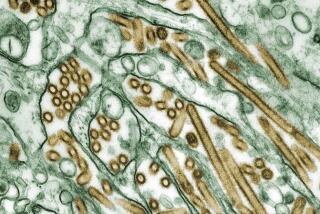CDC’s special unit battles biological enemies
They do not run from the world’s most-feared diseases -- they run to them.
They searched door-to-door for smallpox in the villages of India in the 1960s to vaccinate the masses. They went to Africa in 1976 to confront a horrific new disease, later named Ebola, which causes blood to seep from every bodily opening, even the pores of the skin.
In America, they discovered that Legionnaires’ disease is caused by a bacterium and were first to document in 1981 a mysterious condition that eventually would be called AIDS.
Members of the Epidemic Intelligence Service -- an arm of the Centers for Disease Control and Prevention in Atlanta -- are on the team investigating the anthrax mystery in South Florida that has killed one man and caused 1,000 more to start precautionary antibiotics. Presumably, they also were sent Friday to New York to help with a new anthrax exposure.
Everything about the cases is perplexing. But if they can be solved, many think the EIS will help make it happen.
“The CDC’s Epidemic Intelligence Service model has been replicated in Europe and other countries, so it’s not as unique as it used to be,” said Dr. Art Reingold, a former EIS agent who now leads the epidemiology program in the School of Public Health at the University of California in Berkeley. “But I would say it is unequaled anywhere in the world.”
The EIS still is called to help with outbreaks worldwide, but Oct. 4, the destination was Palm Beach County.
Florida’s first case
Early that day, a state laboratory in Jacksonville had concluded that the rod-shaped bacteria in a Florida man’s lungs were Bacillus anthracis. An anthrax lung infection had not been documented in America since 1976. The case created an instant public-health emergency.
Top officials from the Florida Department of Health flew out of Tallahassee. Within hours, they were joined by 12 people from the CDC, including EIS workers. Two CDC officials also were dispatched to North Carolina, where the man recently visited his daughter.
Family members had taken the 63-year-old Lantana man, Bob Stevens, to a Florida hospital emergency room about 2 a.m. Oct. 2. He was suffering from confusion, high fever and vomiting. He quickly deteriorated. His lungs faltering from the infection, Stevens was put on a respirator to breathe. High-strength penicillin was administered intravenously. He died three days later.
Skin vs. lung infections
By the afternoon of Oct. 4, an investigation was unfolding on two fronts: environment and epidemiology.
Field workers must collect samples from every possible source of contamination in the patient’s environment, said Bill Toth, an epidemiologist for the Orange County Department of Health.
Anthrax bacteria is not common in America, but it still lingers in the wild. The bacteria live in the soil and typically infect grazing animals such as cows, sheep and deer. Humans sometimes get infections through the skin by touching a diseased animal, which carries the bacteria on its hide.
These anthrax skin cases are rarely deadly. But the uncommon lung infections usually lead to death. To get infected this way, a person has to breathe in a large number of anthrax spores. If treated before symptoms emerge, the infection can be thwarted.
Investigation branches out
Searching for the bacteria, field workers collected soil and fertilizer from Stevens’ garden, then sampled his home and the places he often stopped while riding his bike. They went to his favorite fishing holes and tested the inside of his car.
On the epidemiology end of things, workers began constructing a history of Stevens’ movements in the days before he became ill. When Stevens died, investigators were left without their chief witness.
“You talk to family, you talk to friends, you talk to as widespread a number of people as possible to get that history,” said Dr. Richard Hornick, assistant director for internal medicine at Orlando Regional Healthcare. “It’s basic, shoe-leather epidemiology, and it’s very hard work.”
While talking with people close to the patient, health officials also begin testing them for the disease as well.
Beyond that, officials examine discharge records of hospitals for other potential cases that might have been overlooked in the community. They also check with mortuaries to see whether any recent deaths might have been caused by the same disease.
Evidence shows up
In Florida, the far-flung investigation narrowed Sunday, when anthrax was found on Stevens’ computer keyboard at work and in the nasal passage of a co-worker. Bacteria subsequently have been found in the nose of a second co-worker, but neither is ill from anthrax.
The other two people exposed are taking antibiotics to prevent the possibility, and officials quickly launched a massive testing and medication campaign for anyone who spent time at the Boca Raton offices of American Media Inc., where Stevens had been photo editor for one of the supermarket tabloids AMI publishes.
Health officials created a questionnaire for the co-workers, asking where they usually work in the building, with special focus on Stevens’ work area and the mailroom -- where one exposed worker was stationed. On Thursday, FBI sources said they found spores within the mailroom.
Genetic exploration
On another level of the investigation, biologists have been working to assemble the genetic code of the bacterium, which might create a trail that can be followed back to its origin.
“It’s not a whole lot different than the way we use genetics to discover relationships between people,” said Sheldon Schuster, professor and biotechnology program director at UF. “To those people to whom we are most closely related, our DNA sequence is most closely related. The same is true for bacteria.”
Once scientists obtain the bacterium’s code, they can compare it with a database of known strains from around the world. Some reports already have linked the South Florida strain to one isolated in Iowa in the 1950s. But officials say they have yet to finish their sequencing.
All these aspects of the investigation will be coupled with law-enforcement efforts to determine how and when the bacteria were released, by whom and why.
But it’s possible, health officials say, that this case might not be solved completely.
In the early 1990s, Harvard biologist Matthew Meselson traveled to Sverdlovsk, Russia, where 66 people had died in 1979 from anthrax lung infections. He marked the locations of the victims on a map and connected the dots, creating a straight line.
The victims worked downwind from a Soviet biological-warfare facility that must have accidentally leaked the anthrax spores. But Meselson sees no easy solution to the South Florida puzzle.
“Everything about it is very unusual. I cannot think of any obvious explanation,” Meselson said. “But I think they have a good chance of finding out.”
Added Eric Croddy, a senior research associate and biological-weapons expert with the Monterey Institute of International Studies: “We have very good techniques, so I’m holding out hope, but I’m also prepared to never really fully understand what happened here. I think people should also be prepared for a long-term wait and not expect short-term success.”
More to Read
Sign up for Essential California
The most important California stories and recommendations in your inbox every morning.
You may occasionally receive promotional content from the Los Angeles Times.










